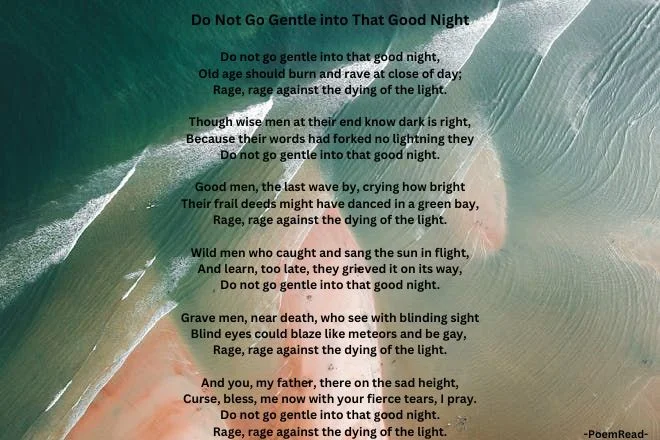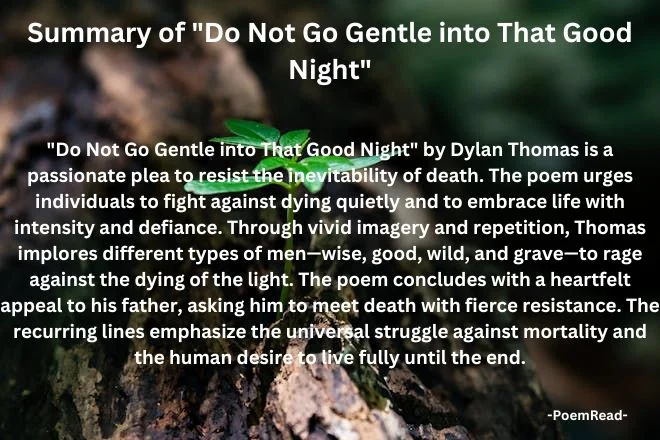
“Do Not Go Gentle into That Good Night” is a powerful villanelle by Dylan Thomas, a renowned Welsh poet. Written in 1951, this poem is a passionate plea to resist the inevitability of death with determination and defiance. Thomas’s expressive use of language and imagery explores universal themes such as life, death, and the human spirit’s resilience.
Understanding Thomas’s background, marked by personal struggles and deep insights, enriches the interpretation of this poem. Through his impactful words, Thomas urges us to live with intensity and to fight against the quiet acceptance of our mortality.
Do Not Go Gentle into That Good Night
Do not go gentle into that good night,
Old age should burn and rave at close of day;
Rage, rage against the dying of the light.
Though wise men at their end know dark is right,
Because their words had forked no lightning they
Do not go gentle into that good night.
Good men, the last wave by, crying how bright
Their frail deeds might have danced in a green bay,
Rage, rage against the dying of the light.
Wild men who caught and sang the sun in flight,
And learn, too late, they grieved it on its way,
Do not go gentle into that good night.
Grave men, near death, who see with blinding sight
Blind eyes could blaze like meteors and be gay,
Rage, rage against the dying of the light.
And you, my father, there on the sad height,
Curse, bless, me now with your fierce tears, I pray.
Do not go gentle into that good night.
Rage, rage against the dying of the light.
Content
- About the Author: Dylan Thomas
- Subject of "Do Not Go Gentle into That Good Night"
- Context of "Do Not Go Gentle into That Good Night"
- Persona, Narrative, and Setting in "Do Not Go Gentle into That Good Night"
- Form and Structure Analysis of "Do Not Go Gentle into That Good Night"
- Theme and Tone of "Do Not Go Gentle into That Good Night"
- Line-by-Line Analysis of "Do Not Go Gentle into That Good Night"
- Poetic and Literary Devices Used in "Do Not Go Gentle into That Good Night"
- Implications and Meanings of "Do Not Go Gentle into That Good Night"
- FAQ
- What is the main subject of the poem?
- Who is the speaker in the poem?
- Who is the speaker addressing in the poem?
- What is the significance of the poem’s form?
- What does the phrase “that good night” represent?
- Why does the poet use the word “rage” repeatedly?
- Can you explain the metaphor “forked no lightning”?
- What does the “dying of the light” symbolize?
- Why does the poem use the refrain "Do not go gentle into that good night"?
- What is the significance of the different types of men mentioned in the poem?
- How does the poem address regret and unfulfilled potential?
- Is the poem only relevant to those who are dying?
- What is the poem’s message about life and death?
- Interactive Summary
About the Author: Dylan Thomas
Dylan Thomas, a renowned Welsh poet born in 1914 in Swansea, Wales, is known for his skillful and emotive use of language. Since his youth, Thomas displayed a remarkable talent for poetry, which later established his position in literary history. His works often tap into universal subjects like life, death, and human existence. These themes are deeply explored in his famous villanelle, ‘Do Not Go Gentle into That Good Night.’
Growing up in Wales significantly influenced Thomas’s poetic style. The natural beauty and cultural heritage of his homeland are frequently reflected in his poetry, giving it a distinct sense of place and identity. Despite facing personal challenges like alcoholism and financial struggles, Thomas published his first book of poems, ’18 Poems,’ at the age of 20, earning critical acclaim and establishing himself as a significant literary figure.
While Thomas encountered difficulties in his life, these experiences added depth and intensity to his writing. The emotional complexity of his personal struggles is mirrored in the vivid imagery and passionate emotion found in his poetry.
Understanding Dylan Thomas’s background is key to interpreting ‘Do Not Go Gentle into That Good Night.’ His personal struggles and deep insights into human experience are reflected in the poem’s passionate plea against quietly accepting death. Thomas’s talent for turning personal hardships into universal themes showcases his mastery of language. It also secures his place as a leading poet of the 20th century.
Subject of “Do Not Go Gentle into That Good Night”
Dylan Thomas’s poem “Do Not Go Gentle into That Good Night” explores the human spirit’s resistance to the inevitability of death. The poem passionately urges us to fight against the end of life with fierce defiance, rather than resignation. This universal message resonates with anyone who has ever contemplated the finality of existence.
The refrain, “Rage, rage against the dying of the light,” serves as a powerful command to live life to its fullest, burning brightly even as life fades. Thomas uses the metaphor of light and dark to symbolize life and death, urging us to hold on to life with all our strength.
This theme is particularly meaningful because it addresses a shared human experience: the approach of death and our instinct to resist it. Through vivid imagery and universal themes, Thomas captures this struggle, making the poem timeless and inspiring.
The impassioned plea in the poem is directed not only at the poet’s father but at all those who face the twilight of their lives. It reminds us that there is beauty and dignity in fighting for every moment of life. This message of resistance and defiance gives the poem its enduring power and appeal.
Context of “Do Not Go Gentle into That Good Night”
Dylan Thomas wrote “Do Not Go Gentle into That Good Night” in 1951, during his father’s declining health. David John Thomas, a former English teacher, had greatly influenced Dylan’s love for literature. Watching his father, once vibrant, fade away was a deeply emotional experience for Thomas. This personal context adds intensity and urgency to the poem.
The early 1950s were also a time of existential reflection and questioning following the devastation of World War II. Many artists and writers explored themes of mortality and the search for meaning. Thomas’s poem addresses personal loss and the broader disillusionment of the era, reflecting a collective struggle to find purpose.
Combining personal grief with the era’s existential concerns, the poem speaks to both individual and universal human conditions. It captures the emotional and philosophical challenges of facing mortality, making it a powerful and relatable piece. This blend of personal and broader context enhances the poem’s impact, giving it a timeless and universal appeal.
Persona, Narrative, and Setting in “Do Not Go Gentle into That Good Night”
Persona
The persona in Dylan Thomas’s “Do Not Go Gentle into That Good Night” is likely the poet himself, expressing deeply personal emotions and experiences. As Thomas addresses his father directly in the final stanza, the persona takes on a role of a concerned and passionate son pleading with his father to resist death. This persona is characterized by urgency, intensity, and emotional depth, reflecting Thomas’s own sentiments towards mortality and the desire to defy its inevitability.
Narrative
The narrative of the poem revolves around the speaker’s impassioned plea to resist death. The speaker addresses different types of men—wise, good, wild, and grave—to illustrate the universal nature of the struggle against mortality. Each stanza presents a different perspective on approaching death, showcasing regrets, valorization of life, and the intense desire to defy the end. The narrative unfolds as a series of urgent pleas and commands, urging readers to embrace life fiercely and resist the fading of the light.
Setting
The setting of “Do Not Go Gentle into That Good Night” is primarily internal and emotional rather than physical. While the poem does not specify a particular physical setting, the emotional setting is one of impending loss, desperation, and defiance. The poem’s setting is characterized by the nearing end of life, the pain of unfulfilled dreams, and the urgent need to hold on to every moment with fervor. This emotional setting creates a sense of immediacy and intensity, driving home the theme of resistance against death.
Form and Structure Analysis of “Do Not Go Gentle into That Good Night”

Form
The poem “Do Not Go Gentle into That Good Night” by Dylan Thomas follows the strict form of a villanelle. A villanelle is a 19-line poem with a specific rhyme scheme and repeating lines. In this case, the poem consists of five tercets (three-line stanzas) followed by a quatrain (four-line stanza).
The rhyme scheme is ABA for the tercets and ABAA for the quatrain. Additionally, the first and third lines of the first tercet are repeated alternately as the last lines of the subsequent tercets and then combined as the last two lines of the poem. This structure creates a rhythmic and cyclical pattern that reinforces the poem’s themes of resistance and defiance.
Structure
The poem’s structure is divided into six stanzas, with each stanza containing a specific thematic focus. The first stanza sets the tone and introduces the central command to resist death. The second stanza discusses wise men’s acceptance of death but their continued resistance. The third stanza shifts to good men lamenting unfulfilled potential.
The fourth stanza presents wild men who lived passionately but now regret their actions. The fifth stanza portrays grave men facing death with newfound clarity and defiance. Finally, the sixth stanza addresses the poet’s father directly, adding a personal and intimate touch to the universal plea for defiance.
Within each stanza, Thomas uses enjambment and punctuation strategically to control the poem’s pacing and emphasize key ideas. Enjambment, where a sentence or phrase continues beyond the line break, creates a sense of flow and momentum, driving the reader forward. Punctuation, such as exclamation marks and semicolons, adds emphasis and helps convey the poem’s urgency and intensity.
Meter
The poem follows a metrical pattern known as iambic pentameter, which consists of five iambs per line. An iamb is a metrical foot consisting of one unstressed syllable followed by one stressed syllable. The iambic pentameter gives the poem a regular and flowing rhythm, contributing to its lyrical and musical quality.
The combination of the villanelle form, strict rhyme scheme, and iambic pentameter meter creates a harmonious and melodic structure for the poem. The structured framework not only enhances the poem’s aesthetic appeal but also emphasizes its thematic content. Specifically, it highlights the urgency and intensity of the speaker’s plea to resist death.
Theme and Tone of “Do Not Go Gentle into That Good Night”
Theme
The main theme of “Do Not Go Gentle into That Good Night” is the fierce resistance against death. Dylan Thomas passionately urges readers to fight against the inevitability of death with all their strength and vitality. The poem calls for active resistance rather than passive acceptance. This theme is emphasized through the repeated refrains “Do not go gentle into that good night” and “Rage, rage against the dying of the light,” which urge us to hold on to life fiercely.
Additionally, the poem explores themes of living passionately and the regret of unfulfilled potential. By describing different types of men—wise, good, wild, and grave—Thomas shows that regardless of the life one has led, the approach of death should be met with courage and defiance. These examples reflect various aspects of humanity’s shared experience, highlighting the universal nature of the poem’s message.
Furthermore, the poem touches on the pain of realizing it’s too late to change or achieve something significant. This brings a sense of urgency to make the most of the remaining time. Despite its focus on death, the poem ultimately affirms the value of life. It highlights the importance of living with passionate intensity, no matter how close one is to death. This theme is a powerful testament to the human spirit’s resilience and the desire to live fully, even in the face of death. It reminds us that our response to the end can be as meaningful as the life we’ve lived.
Tone
The tone of “Do Not Go Gentle into That Good Night” is complex, blending urgency, passion, defiance, and sorrow. Thomas uses commanding language and a rhythmic structure to create a sense of insistence and desperation. The repetition of refrains intensifies this urgency, making the plea to resist death feel immediate and powerful. Moreover, the poem’s emotionally charged language, filled with vivid imagery and metaphors like “burn and rave at close of day” and “blaze like meteors,” evokes a sense of fierce energy and resistance.
However, beneath this defiance lies a deep undercurrent of sorrow and grief. The speaker, likely Thomas himself, grapples with the pain of impending loss, not just issuing a battle cry against death but also dealing with the emotional weight of it. This grief is subtly integrated into the poem, creating a tone that combines defiant resistance with sorrowful reflection.
This interplay of urgency, passion, defiance, and grief gives the poem its compelling power. It resonates with readers both intellectually and emotionally, capturing the human experience of facing aging and death. Ultimately, Thomas’s work encourages us to embrace life’s vibrancy and energy while acknowledging the sorrow of its inevitable end. It serves as a reminder to “rage, rage against the dying of the light,” urging us to confront mortality with both courage and defiance.
Line-by-Line Analysis of “Do Not Go Gentle into That Good Night”
First Stanza
“Do not go gentle into that good night,”
In the opening line, Dylan Thomas establishes the tone and theme of the entire poem. The imperative “Do not go gentle” acts as a command, encouraging readers to actively resist accepting death without a fight. The phrase “into that good night” is a metaphor for dying, where “night” represents the end of life.
The use of the adjective “good” introduces irony, implying that although death may seem peaceful, the speaker rejects the idea of accepting it quietly. This line immediately establishes the poem’s central message of defiance against the inevitability of death.
“Old age should burn and rave at close of day;”
Here, Thomas suggests that even in the twilight of life (“old age” and “at close of day”), people should continue to live with passion and intensity. The verbs “burn” and “rave” suggest a fierce and energetic existence, opposing the calm and quiet acceptance of death. “Burn” connotes a bright, intense flame, symbolizing a life lived with vigor.
“Rave” adds a sense of wildness and emotional intensity, indicating that one should not go quietly into the night but should instead resist with all their might. Therefore, the verbs “burn” and “rave” suggest intense emotion and activity, contrasting with the calm typically associated with old age. This line reinforces the idea that old age is not a time for resignation but for continued struggle and passion.
“Rage, rage against the dying of the light.”
This line, which is also one of the poem’s refrains, summarizes the main message of defiance. The word “rage” is a powerful verb that connotes intense, almost violent resistance. The repetition of “rage” emphasizes the urgency and emotional force behind the plea.
“Against the dying of the light” continues the metaphor of light representing life and its inevitable end. By urging to “rage” against it, Thomas is calling for a fierce struggle against death. This line highlights the poem’s central theme, emphasizing the speaker’s advocacy for an active and passionate resistance against the end of life.
Summary of the Stanza
The first stanza of “Do Not Go Gentle into That Good Night” introduces the central command of the poem: to resist death with all one’s might. Thomas uses imperative language and vivid imagery to convey a sense of urgency and passion. The metaphor of light and dark, representing life and death, is established here and will be carried throughout the poem.
The repetition of the plea to “rage” against the dying of the light highlights the intensity of the speaker’s emotions and sets the tone for the rest of the poem. This stanza lays the groundwork for the exploration of different responses to death in the following stanzas, each reinforcing the central theme of defiance against the inevitable.
Second Stanza
“Though wise men at their end know dark is right,”
In this line, Thomas begins to explore the reaction of “wise men” to the approach of death. Here, the term “wise men” implies those who are knowledgeable and have lived thoughtfully. When Thomas mentions “at their end,” he means they are nearing death. The use of “dark” symbolizes death, while stating “dark is right” recognizes its natural inevitability. Wise men comprehend and embrace death as a part of life, but this awareness doesn’t lead to passive acceptance.
“Because their words had forked no lightning they”
This line explores why wise men resist death. Despite their wisdom, their words “had forked no lightning.” This metaphor implies that their insights and teachings haven’t had the impactful effect they desired; their words haven’t struck with the power of lightning. This feeling of unmet potential or a lack of significant influence fuels their resistance. While they acknowledge death’s inevitability, their motivation stems from the desire to make a more substantial impact.
“Do not go gentle into that good night.”
The refrain is repeated, reinforcing the poem’s central command. Even though wise men understand death’s inevitability and acknowledge their contributions may not have been as impactful as desired, they still resist. The repetition in the poem emphasizes the urgent and universal plea to fight against quietly accepting death.
Summary of the Stanza
In the second stanza, Thomas focuses on wise men who, despite their acceptance of death’s inevitability (“dark is right”), resist the end because they feel their words have not achieved the powerful impact they desired (“forked no lightning”). This stanza further develops the poem’s theme of defiance, illustrating that even those who grasp death’s naturalness continue to wrestle against it.
The repetition of the refrain “Do not go gentle into that good night” highlights the poem’s central message and the emotional intensity behind the call to resist death. This stanza highlights the universal struggle against mortality. Thereby, it shows that the impulse to fight against life’s end is shared by all, regardless of wisdom or insight.
Third Stanza
“Good men, the last wave by, crying how bright”
In this line, Thomas introduces the term “good men,” likely referring to those who have led moral and righteous lives. “The last wave by” suggests that these men are nearing the end of their lives, similar to the final wave before reaching the shore.
“Crying how bright” indicates that these men are expressing sorrow over the brevity and fragility of their accomplishments and lives. The use of the word “bright” conveys a feeling of vitality and the desire to make a positive impact. Their regret shows an awareness of the impermanence of their deeds.
“Their frail deeds might have danced in a green bay,”
This line further explores the regrets of good men. “Frail deeds” refers to their actions, which, despite being good, are delicate and short-lived. The “green bay” is a metaphor for life and its opportunities. Therefore, the “frail deeds” imply that the good men regret that their actions were not as impactful as they could have been.
They wish their deeds had been more vibrant and livelier, much like the dance in a lively, green bay. The use of “might have danced” suggests a sense of missed potential or unfulfilled promise, as if their deeds could have had a more lasting impact. This sense of regret fuels their desire to resist the end.
“Rage, rage against the dying of the light.”
The refrain is repeated, reinforcing the poem’s core message. Good men, aware of life’s fragility and the impermanence of their deeds, are urged to “rage” against approaching death. The repetition of “rage” highlights the emotional intensity and universal call to fight against the dying of the light. Furthermore, this maintains the poem’s urgent and defiant tone.
Summary of the Stanza
In the third stanza, Thomas shifts his focus to “good men,” who lament the fragility and fleeting nature of their virtuous deeds as they approach death (“the last wave by”). These men recognize how bright and impactful their actions could have been, symbolized by the image of their deeds dancing in a “green bay.”
Despite this recognition, the men regret that their contributions were not as lasting as they had hoped. This regret fuels their resistance to death, aligning with the poem’s central theme of defiance. The repetition of the refrain “Rage, rage against the dying of the light” reinforces the call to resist the end of life passionately and fervently. It emphasizes the emotional and universal nature of this struggle. Additionally, this stanza explores how people react to mortality. Thereby, it draws attention to the regret and desire for more time that fuel the resistance to death.
Fourth Stanza
“Wild men who caught and sang the sun in flight,”
This line introduces “wild men,” likely those who lived for adventure and seized life’s moments with gusto. “Caught and sang the sun in flight” is a metaphor suggesting that these men have seized life’s opportunities and lived vibrantly. “Sun in flight” symbolizes the pinnacle of life and joy, capturing the essence of living with passion and excitement. This expression suggests that one should seize the day and celebrate the transient beauty of life.
“And learn, too late, they grieved it on its way,”
This line transitions to the realization of the wild men. Despite their vibrant lives, they realize belatedly that their joyful celebration of life (“sang the sun”) also included mourning its inevitable passing (“grieved it on its way”). The line acknowledges that even the most passionate lives must confront the reality of death. The use of “too late” emphasizes the regret and missed opportunity to understand that their wild ways couldn’t stop time or death’s arrival.
“Do not go gentle into that good night.”
The refrain is repeated, emphasizing the poem’s central message. Wild men, despite their late realization of life’s transient nature and their mourning of its inevitable end, are urged to resist death. It serves as a reminder to the wild men, and to all readers, that regardless of past regrets, one should not surrender to death without a fight.
Summary of the Stanza
In the fourth stanza, Thomas shifts focus to “wild men,” individuals who have lived intensely and passionately. They are likened to ones who “caught and sang the sun in flight,” symbolizing their seizing of life’s opportunities and cherishing joyful moments. However, they realize too late that their vibrant lives also involved an underlying sorrow for life’s end (“grieved it on its way”). This belated understanding brings regret as they grasp the fleeting nature of their passionate existence.
Despite this realization, the refrain “Do not go gentle into that good night” urges these wild men to resist death with the same passion they embraced life. The stanza reinforces the theme of defying death’s inevitability, highlighting that even those who lived fully should not accept death passively. The refrain’s repetition stresses the universal call to fight against dying light, maintaining the poem’s emotional and powerful tone.
Fifth Stanza
“Grave men, near death, who see with blinding sight”
In this line, Thomas introduces the “grave men,” those who are nearing the end of their lives and are often associated with seriousness and contemplation. “Near death” signifies their proximity to the end of life. “See with blinding sight” suggests a sudden clarity or understanding that comes with approaching death.
The phrase “blinding sight” is paradoxical, as blindness usually indicates lack of vision. Here, it emphasizes the overwhelming and perhaps painful clarity that comes with the realization of mortality. These men have a deep, almost startling awareness of their lives and their impending end.
“Blind eyes could blaze like meteors and be gay,”
This line continues to explore the paradox of the grave men’s vision. “Blind eyes” symbolize those who are spiritually or metaphorically blind, yet they have the potential to “blaze like meteors.” Meteors are bright, fleeting lights that blaze across the sky, symbolizing moments of brilliance and intensity.
The phrase “and be gay” suggests that even in their final moments, these men could find joy and brilliance, contrasting sharply with the usual solemnity of approaching death. This line emphasizes that the potential for vitality and passion remains, even in the face of death.
“Rage, rage against the dying of the light.”
The refrain is repeated once more, serving as a powerful and persistent reminder of the poem’s central theme. The grave men, despite their sudden clarity and the realization that they are nearing the end, are urged to “rage against the dying of the light.”
It reinforces the theme that even those who have seen the light fade in their final moments should resist passively giving in to death. Ultimately, it is a call to all, regardless of their circumstances, to resist the end with passion and strength.
Summary of the Stanza
In the fifth stanza, Thomas focuses on “grave men” who, nearing death, experience a moment of clarity, described as “blinding sight.” This sudden insight allows them to see the truth of their existence with startling vividness. The poem suggests that despite their serious contemplation, these men still have the capacity for joy and brilliance, represented by “blind eyes that could blaze like meteors and be gay.” This imagery highlights the contrast between the gravity of their situation and the possibility of a radiant, joyful resistance against death.
The repetition of the refrain, “Rage, rage against the dying of the light,” reinforces the poem’s call to defiance. It emphasizes that even those who are near death and have gained deep insight should fight against the end with the same passion. This stanza deepens the exploration of resistance against mortality. It portrays the grave men’s struggle to maintain their vitality and defiance until the very end. The refrain’s repetition maintains the poem’s powerful tone, urging all to resist the passive acceptance of death.
Sixth Stanza
“And you, my father, there on the sad height,”
In this line, Thomas shifts the focus from generalized categories of men to a personal address to his father. The phrase “on the sad height” is a metaphor for being close to death, positioned at the peak of life, looking down at the inevitable end. The word “sad” conveys the sorrow and emotional weight of this moment. This line adds a deeply personal and emotional dimension to the poem, as Thomas directly pleads with his father to resist death.
“Curse, bless, me now with your fierce tears, I pray.”
Here, Thomas is asking for a powerful emotional response from his father. The juxtaposition of “curse” and “bless” suggests a mix of anger and love, reflecting the complex emotions involved in facing death. “Fierce tears” implies a strong, passionate reaction, urging his father to fight against the dying of the light with intense emotion. The phrase “I pray” shows Thomas’s earnest plea, emphasizing the urgency and desperation of his request.
“Do not go gentle into that good night.”
The refrain is repeated for the last time, serving as a final plea to the poet’s father. Thomas is imploring his father specifically to resist death and not to accept it quietly. The repetition serves to reinforce the urgency and personal significance of this plea. By addressing his father directly, Thomas makes the universal message of the poem even more intimate and powerful.
“Rage, rage against the dying of the light.”
The poem’s final line, a repeated refrain, captures its core message of defiance and resistance against death. Ending with this line, Thomas leaves readers with a strong emotional command, highlighting the ongoing struggle against mortality. The repetition of “rage” intensifies this struggle, creating an urgent and deeply moving conclusion.
The poem closes with the same line that ends each stanza, reinforcing its central message. It’s a powerful directive to live fiercely, confront death with an unyielding spirit, and refuse to accept its inevitability passively.
Summary of the Stanza
In the sixth stanza, Thomas makes a personal plea to his father, who is nearing death (“on the sad height”). This direct address adds a deeply emotional and intimate layer to the poem. He urges his father to show strong emotions (“curse, bless, me now with your fierce tears”), reflecting the complex mix of anger and love that comes with facing death. The repetition of the refrains “Do not go gentle into that good night” and “Rage, rage against the dying of the light” reinforces the poem’s central message of defiance.
By concluding with this personal appeal, Thomas ties the universal themes of the poem to his own life, making the message of resistance against death even more powerful. The final repetition of the refrain leaves the reader with a lasting impression of the passionate struggle against the inevitable, emphasizing the enduring human spirit and the fight to maintain life’s vitality until the very end.
Poetic and Literary Devices Used in “Do Not Go Gentle into That Good Night”

Villanelle Form
Dylan Thomas’s “Do Not Go Gentle into That Good Night” is a villanelle, a highly structured form of poetry with 19 lines consisting of five tercets (three-line stanzas) followed by a quatrain (four-line stanza). This form uses two repeating rhymes and two refrains. The strict pattern of the villanelle contributes to the poem’s musical quality and emphasizes its themes through repetition.
The refrains “Do not go gentle into that good night” and “Rage, rage against the dying of the light” echo throughout the poem, reinforcing the central message of defiance against death. The rigid structure contrasts with the emotional intensity of the content, highlighting the tension between the inevitability of death and the human desire to resist it.
Metaphor
Thomas uses metaphors extensively to convey the abstract concepts of life and death. The “good night” is a metaphor for death, suggesting a peaceful and natural end, while “the dying of the light” represents the end of life, with light symbolizing life itself. The “close of day” metaphorically represents the end of life, while “forked no lightning” implies unfulfilled potential or impact.
These metaphors transform abstract ideas into tangible images, making the poem’s message more vivid and impactful.By using everyday images like night and light, Thomas communicates complex emotions and themes in a way that is both relatable and profound. The metaphors serve to universalize the experience of facing death, allowing readers to connect deeply with the poem’s themes.
Repetition
Repetition is a key device in the poem, with the refrains “Do not go gentle into that good night” and “Rage, rage against the dying of the light” repeated throughout. This repetition creates a rhythmic and insistent tone, underscoring the urgency of the poem’s message. Each repetition of the refrains builds emotional intensity, driving home the call to resist death with passion and vigor.
The repeated phrases also serve to unify the poem, linking the different stanzas and the various types of men described in their shared defiance against death. The persistent repetition mirrors the relentless human spirit and its unyielding resistance to the end.
Imagery
In Dylan Thomas’s “Do Not Go Gentle Into That Good Night,” imagery plays a vital role in conveying themes of life, death, and defiance. The poem vividly contrasts light, symbolizing vitality and passion, with darkness, representing death. Images of “burning,” “blazing meteors,” and “the sun in flight” evoke life’s intensity and brevity. Fire and celestial imagery remind us of life’s fleeting beauty and the need to embrace it fully.
The poem also uses journey-related imagery, like “the last wave by” and “the sad height,” to depict life’s final stages. This imagery enhances the poem’s emotional impact, emphasizing the urgency of the speaker’s plea. Through these vivid images, Thomas creates a landscape that resonates with readers, emphasizing the human spirit’s resilience in the face of mortality.
Paradox
The poem employs paradoxes to express the complex and often contradictory emotions associated with death. For instance, “blind eyes could blaze like meteors and be gay” suggests that even those who are nearing death (and possibly losing sight) can still experience moments of intense brilliance and joy. These paradoxes highlight the coexistence of despair and hope, resignation and defiance, within the human experience of facing death.
The use of paradox underscores the poem’s message that even in the face of inevitable death, there remains potential for life’s most vibrant expressions. This complexity adds depth to the poem’s emotional landscape, reflecting the multifaceted nature of human reactions to mortality.
Apostrophe
In the final stanza, Thomas uses the apostrophe, directly addressing his father, “And you, my father, there on the sad height.” This direct address brings an intimate and personal dimension to the poem, heightening the emotional impact. By speaking directly to his father, Thomas makes the universal message of the poem more personal and touching.
The apostrophe transforms the poem from a general exhortation to a heartfelt plea, emphasizing the deep emotional stakes involved. This device connects the reader to the speaker’s personal experience, making the universal struggle against death resonate on a more individual level.
Symbolism
Symbolism plays a crucial role in “Do Not Go Gentle into That Good Night.” The primary symbols are light and night, representing life and death, respectively. The “dying of the light” symbolizes the end of life, while “that good night” refers to the peacefulness associated with death. Additionally, the images of “meteors” and “the sun in flight” symbolize the fleeting but intense moments of life.
These symbols help to communicate the poem’s themes more powerfully by invoking common, easily understood imagery. Through symbolism, Thomas conveys the profound message that life’s brightness should be fiercely defended against the encroaching darkness of death.
Alliteration
Thomas uses alliteration to enhance the musical quality of the poem and to emphasize certain emotions and actions. Phrases like “Good men, the last wave by” and “blind eyes could blaze” use alliteration to create a rhythmic flow and draw attention to key concepts.
The repetition of consonant sounds adds to the poem’s lyrical quality, making the exhortations to resist death more memorable and impactful. Alliteration helps to underscore the emotional intensity of the poem, making the plea to fight against death resonate more deeply with the reader.
Consonance and Assonance
The poem employs consonance and assonance to create a harmonious and rhythmic sound. Consonance, the repetition of consonant sounds, can be seen in phrases like “last wave by” and “fierce tears.” Assonance, the repetition of vowel sounds, is present in lines such as “blind eyes could blaze.”
These sound devices contribute to the poem’s musicality and help to reinforce its themes. The use of consonance and assonance adds to the overall aesthetic experience of reading the poem, making the urgent call to resist death more compelling through its pleasing auditory effects.
Enjambment
Enjambment, the continuation of a sentence or clause across a line break, is used throughout the poem to maintain its rhythmic flow and to build suspense. For example, in the line “Good men, the last wave by, crying how bright / Their frail deeds might have danced in a green bay,” the thought extends beyond the first line, compelling the reader to move forward. Enjambment creates a sense of urgency and continuity, mirroring the relentless march of time and the ongoing struggle against death. It helps to keep the reader engaged and emphasizes the poem’s theme of persistent defiance.
Irony
Thomas employs irony to deepen the poem’s emotional impact and to highlight the contradictions inherent in the human experience of facing death. For instance, the “grave men” who are “near death” gain “blinding sight,” suggesting that clarity often comes too late. The “wild men” who “caught and sang the sun in flight” end up “grieving” the very thing they celebrated, indicating the bittersweet nature of life’s passions.
These ironic elements underscore the complexity of human emotions and the often-paradoxical nature of our responses to mortality. The use of irony adds a layer of depth to the poem, inviting readers to reflect on the multifaceted nature of life and death.
Anaphora
Anaphora, the repetition of a word or phrase at the beginning of successive clauses, is used effectively in the poem. The refrains “Do not go gentle into that good night” and “Rage, rage against the dying of the light” are repeated at the beginning of multiple lines, creating a powerful rhetorical effect.
This repetition emphasizes the poem’s central themes and reinforces the speaker’s passionate plea. Anaphora contributes to the poem’s urgency and insistence, making the message of defiance against death more forceful and memorable.
Personification
Personification, giving human qualities to non-human entities, is evident in the poem. Death is personified as “that good night,” suggesting a peaceful, almost welcoming presence. Similarly, “the dying of the light” is depicted as an active force against which the speaker urges resistance.
By personifying these abstract concepts, Thomas makes them more relatable and tangible, enhancing the emotional impact of the poem. This device helps to dramatize the struggle against death, making the abstract fight feel more immediate and personal.
Contrast
Thomas uses contrast to highlight the differences between the various types of men and their responses to death. For example, “wise men” recognize the inevitability of death but still resist, while “wild men” live passionately yet regret their past. These contrasts illustrate the universal nature of the struggle against mortality, regardless of one’s life choices or personality.
The use of contrast enhances the poem’s exploration of human reactions to death, showing that the desire to resist the end is a common thread that unites all people. This device underscores the poem’s central message by highlighting the varied yet similar ways in which different individuals confront their mortality.
Implications and Meanings of “Do Not Go Gentle into That Good Night”
The implications and meanings of Dylan Thomas’s “Do Not Go Gentle Into That Good Night” are as rich and varied as the poem’s language and form. At its core, the poem is a meditation on death and the human response to it. It carries a universal message that transcends the personal circumstances of its creation.
The Universal Struggle Against Death
One of the poem’s primary implications is the universal struggle against death. While the poem was written for Thomas’s father, it speaks to the common human experience of facing the end of life. It encourages not just the sick and the elderly but all people to fight bravely against death, to live with vibrancy and energy, despite the fragility and brevity of human life.
The Celebration of Life
Another significant implication of the poem is the celebration of life. Thomas’s repeated exhortations to “rage against the dying of the light” serve as a reminder to cherish and fight for every moment of existence. The poem suggests that life’s value lies in its intensity and the passion with which it is lived.
The Personal and the Universal
The poem also bridges the personal and the universal. While it is a son’s plea to his father, it resonates with anyone who has contemplated the inevitability of death. The poem’s emotional depth and the universality of its themes allow it to connect with readers from all walks of life, making it a timeless piece of literature.
Reflection on Human Emotions and Regrets
Furthermore, the poem reflects on the complexity of human emotions and the regrets that come with aging. It speaks to the desire to have made a mark on the world and the realization that time is running out. This reflection adds a layer of poignancy to the poem, as it captures the bittersweet nature of human existence.
A Call to Defiance
Ultimately, “Do Not Go Gentle Into That Good Night” is a call to defiance. It is a powerful statement against passivity in the face of life’s greatest certainty. The poem’s lasting impact lies in its ability to inspire readers to live fully, with courage and determination, until the very end.
In summary, the poem’s implications and meanings are as deep as they are simple: it is a call to live life to the fullest, to resist the end with every fiber of our being, and to embrace the beauty and tragedy of the human condition with open arms. It’s a reminder that our response to the end can be as significant as the life we’ve lived.
FAQ

What is the main subject of the poem?
The main subject of the poem is the struggle against death. It is a plea for fighting against the inevitable end of life with passion and defiance.
Who is the speaker in the poem?
The speaker is generally considered to be the poet himself, Dylan Thomas, especially since the poem is understood to be written for his ailing father.
Who is the speaker addressing in the poem?
The speaker addresses different types of men facing death, including wise men, good men, wild men, and grave men. In the final stanza, the speaker makes a personal plea to his father, adding a poignant and intimate dimension to the poem.
What is the significance of the poem’s form?
The poem is a villanelle, a form that uses repetition and rhyme to create a powerful emotional effect. The strict structure of the villanelle reinforces the poem’s central message through its repetitive refrains.
What does the phrase “that good night” represent?
The phrase “that good night” is a metaphor for death. It suggests a peaceful end, but the poem urges resistance against this tranquility.
Why does the poet use the word “rage” repeatedly?
The repetition of “rage” emphasizes the intensity of the speaker’s feelings. It signifies a vehement refusal to accept death quietly and a call to battle against its approach.
Can you explain the metaphor “forked no lightning”?
The metaphor “forked no lightning” implies that despite their wisdom, the wise men feel they have not made a significant impact or achieved something extraordinary.
What does the “dying of the light” symbolize?
The “dying of the light” symbolizes the loss of life’s vitality. It represents the decline into death and the end of consciousness.
Why does the poem use the refrain “Do not go gentle into that good night”?
The refrain serves as a powerful imperative, emphasizing the urgency and importance of resisting death. It echoes throughout the poem, reinforcing the central message and urging readers to embrace life’s vitality.
What is the significance of the different types of men mentioned in the poem?
The different types of men—wise, good, wild, and grave—represent varied approaches to life and death. They illustrate the universal human experience of confronting mortality and highlight the diversity of responses to the inevitability of death.
How does the poem address regret and unfulfilled potential?
The poem reflects on the regrets and unfulfilled aspirations that people may face as they near the end of their lives. It emphasizes the importance of living passionately and purposefully to avoid such regrets.
Is the poem only relevant to those who are dying?
While the poem was written for Thomas’s father as he approached death, its message resonates universally. It speaks to the human spirit’s resistance to the end of life, making it relevant to all people, regardless of their stage in life.
What is the poem’s message about life and death?
The poem’s message is that life should be lived with passion and defiance until the very end. It encourages a spirited response to the inevitability of death, suggesting that the way we face our end is as important as how we live our lives.
Interactive Summary

Imagine standing on the edge of life, facing the inevitable approach of death. In “Do Not Go Gentle into That Good Night,” Dylan Thomas passionately urges readers to defy death with every ounce of their being. Through powerful imagery and emotional intensity, the poem celebrates life’s brilliance and urges us to resist the fading of that light.
The poem’s structure, as a villanelle, enhances its musical quality and emphasizes its central themes through repetition. Thomas uses metaphors like “the dying of the light” and “that good night” to symbolize life and death, while the refrain “Do not go gentle into that good night” echoes the urgent call to resist death.
Each stanza portrays different types of men facing death, highlighting the universal human experience of confronting mortality. The poem reflects on regret, unfulfilled potential, and the desire to leave a meaningful legacy. It’s a personal plea to Thomas’s father but resonates universally, urging all to live passionately and defy death’s quiet acceptance.
Ultimately, “Do Not Go Gentle into That Good Night” is a timeless testament to the human spirit’s resilience and the profound desire to live life fully, even in the shadow of death. It challenges us to embrace life’s intensity, celebrate our vitality, and leave behind a legacy of passion and defiance.
If you found “Do Not Go Gentle into That Good Night” compelling, be sure to read our analysis of “Nothing Gold Can Stay.” It offers another powerful reflection on life’s fleeting moments and the beauty of transience.
RELATED POSTS
View all



